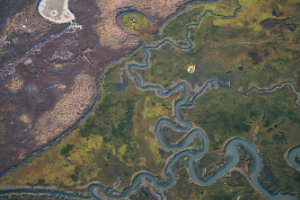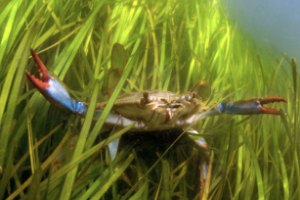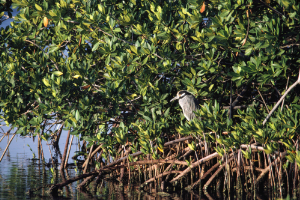Supratidal Zone
Area above high tide that extends into higher lands. This is also known as the splash zone or supralittoral zone.
Intertidal Zone
Area that is covered during high tide and barren during low tide. Often includes rocky cliffs and mud flats. There are very few organisms that are resilient enough to live in this harsh environment. Also known as the littoral or transition zone.
Subtidal Zone
Area that extends past the low tide line into open waters. This area is continuously covered by water.
Organisms: Algae, fungi, snails, barnacles
Organisms: Crabs, barnacles, mussels, shrimps, snails, sea urchins
Organisms: Fish, marine organisms, crabs

Coastal Habitats
Coastal habitats can vary depending on geographic region. The three main types of estuary habitats include salt marshes, seagrass, and mangroves. RAE works to restore all of these habitats in order to preserve an ecosystem that has brought tranquility, education, and jobs to millions of people all over the country.
Salt marshes
Salt marshes are coastal wetlands dominated by grass and shrub plants. Salt marshes are often characterized by having very high salinity (salt content) and sporadic small islands. Organisms that live here must withstand harsh environments due to rapidly changing tides and salinity. In addition to providing key marine habitat, salt marshes help to filter pollutants, stabilize the shoreline, serve as a buffer to storms and flooding, and sequester and store large amounts of carbon.
Seagrass
Seagrass (or submerged aquatic vegetation) habitats are constantly submerged underwater and consist of aquatic grasses, providing food and shelter to many aquatic species. These species include, but are not limited to, fish, crabs, manatees, and sea turtles. Sea grasses are very sensitive to water pollution and changes in pH.
Mangroves
Mangroves are a type of tropical forest found in coastal areas that are regularly flooded by tidal water. They are among the most carbon-rich forests in the tropics and provide many ecosystem services. They provide spawning grounds for fish species, filter pollutants from coastal waters, and protect coastal development and communities against storms, floods, and erosion. These unique evergreen plants can withstand high salinity and harsh environments.



Why are estuaries important?
Maintains Vital Food Supplies
Healthy estuaries produce more food per acre than the richest Midwestern farmland because of the fertile mix of nutrients from land and sea. Because of this, there are many types of species that are harvested for human consumption, such as Chesapeake Bay blue crab.
Protect Nature’s Bounty
Beyond providing food for our consumption, estuaries are the home of thousands of species of fish, birds, plants, and animals that depend on healthy habitat for their survival.
Supports the Economy
There are 56 million jobs in the fishing, tourism, and recreational boating industries — all of which depend on healthy estuaries for their products and customers. Estuaries and coastal waters provide essential habitat for 75% of America’s commercial fish catch and 80–90% of the recreational fish catch. In addition, estuaries provide significant “services” which directly benefit Americans. For example, estuaries protect landowners from flood waters and provide important buffers that protect water quality by filtering runoff.
Preserves a Way of Life
Healthy estuaries support unique, centuries-old cultures, traditions, and ways of life dependent upon the diversity of wildlife for everything from livelihoods to storytelling. Estuary restorations will maintain these ways of life — and the heritage they embody — for the benefit of future generations.
In addition, nearly 200 million Americans — approximately 70% of the population — visit estuaries and coastal areas every year for vacations, recreation, sport, or sightseeing. The more we do to restore estuaries, the more Americans will be able to experience their amazing bounty.
For the 110 million Americans who live near estuaries, they are essential to people’s quality of life: for their scenic beauty, for their recreational opportunities, for their bounty, for their abundance of life, and for their mere presence. Restoring estuary habitat is the only way to ensure that this quality of life is protected and improved.
Provides Ecosystem Services
Estuaries also act as storm buffers to the mainland, protecting residential areas from harsh storms such as hurricanes. When flooding occurs, estuaries soak up a lot of the excess water and lessen the damage dealt to local habitats and communities.
Estuaries also naturally remove pollutants like toxic chemicals, excess sediment, and excess nutrients. Organisms like salt marsh plants and oysters act as filters, clearing the water and making it safer for other living things.
In addition, coastal wetlands also remove and store large amounts of carbon — an ecosystem service referred to as blue carbon.
Education
Estuaries are an educational resource that must be maintained as living laboratories of life. As one of the most biologically diverse ecosystems in America, the opportunities for learning are endless. In order to secure these educational opportunities for future generations, restoring and protecting estuaries is essential.
